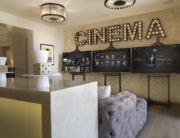Home theatre systems have risen in popularity thanks to the impeccable personal movie theatre experience they provide at the comfort of our homes, minus the long waiting lines for tickets or overpriced food from the cafeteria that people generally experience in a typical movie theatre.
While the definition of ‘home theatre’ mostly varies depending on the budget, a true home system consists of a particular set of components. The art of audio video design and installation along with the complex add-ons are truly the ones that will really bring out the most in a home theatre system. The most essential of these components are:
The Display
To be able to have an immersive viewing experience, one has to get at least the very basic component right: the display. Displays come in mostly two variants, which are further divided into sub-categories. You can either get a large HD TV or a 4K TV, although the latter is recommended for a better experience and future-proof installation. But if you want the very best, you can opt for a high-quality projector and a white screen setup, which is the closest theatre-like screen one can get at home.
The Receiver
The receiver is what you can call the backbone of your home theatre setup. It is the central hub that connects every audio video installation within your home theatre setup, such as the video input, the display device, speakers and also as amplifier. While amplifiers and pre-amps are quite advanced and complex as these are used to fine tune and control the minute audio and video system details, they are usually equipped within the receiver itself in most cases. For more expensive setups, dedicated amplifiers are used along with separate receivers as they provide a greater quality and degree of control over your connected devices.
The Sound System
Having the very best display is basically useless if your setup does not have any accompanying sound system to go with it. Just basic speakers or those that come embedded in the TV itself won’t do the job; you need to have a surround sound system that will bombard you with audio from all around the room. The design of audio video installation should be such that while the display device is laid out right in front of your seating area, the speakers are spread out around the room to provide a much immersive theatre-like experience.
Speakers are of many configurations: 2.1, 5.1 and 7.1. For a home theatre system, just 2.1 won’t cut it as it has one subwoofer and two front speakers. You need at least 5.1 or 7.1 configuration, especially the 7.1 which consists of the entire set: two front speakers, two back speakers, two side speakers, one central speaker and a subwoofer. The sound system is connected to the receiver and can be controlled accordingly.
Surge Protectors
Surge protectors are unsung heroes of every home theatre setup. They can seem so insignificant, but they play a very important role in your home theatre setup: protection. Sudden electrical surges are common, especially during rainy and stormy weather. One sudden electrical surge can fry the electronic chips of every single one of your expensive home theatre devices, whether it be a TV or speakers or the receiver itself. Surge protectors act as a barrier between the external current and your home theatre devices, and when a sudden electrical surge is received, the surge protector cuts off power line to your devices, protecting them. Surge protectors are a must have for every home theatre system, and are indispensable when it comes to protecting your expensive equipment from unstable electrical shocks.
Home Theatre Room and Decoration
Even if you have readied all the essential home theatre devices, the final ‘experience’ will be incomplete unless you set them up in a dedicated home theatre room complete with lightings, blinds and couches. To do this, the first thing you have to do is choose an empty room as your home theatre hall. It should be big enough not to feel cramped and should have a spacious feel even with all equipment in place.
Professional audio video design firms specializing in installation of home theatre systems often offer to design the entire room from ground up, including setting up the environment and lights. The lights and window blinds can be made to be automatic and shut down on their own when a movie starts playing on the screen. Mood lighting is a small but essential aspect for a fully immersive home theatre experience, along with sufficient number of comfortable couches for your family and friends to sit and enjoy the cinema. You can even add other decorations such as dark LED lights, a mini-bar or a serving table for food, snacks and drinks, and neon-lit exit signs for added touch of a personal home theatre.
It is important to plan ahead on every detail before settling for the components and decorations. You can ask your local home theatre store for help in designing the layouts after which they will install all the necessary components in place.











